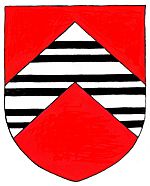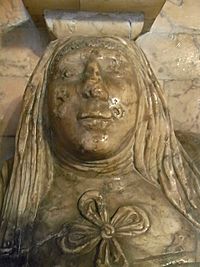Sir Baynham Throckmorton, 2nd Baronet facts for kids
Sir Baynham Throckmorton, 2nd Baronet (born around 1606 – died May 28, 1664) was an important figure from Clearwell, Gloucestershire. He was a strong supporter of the King during the English Civil War. He also served as a Member of Parliament (MP) for Gloucestershire from 1661 until his death.
Contents
Family Background
Baynham Throckmorton was born around 1606. His father was Sir William Throckmorton, 1st Baronet, who passed away in 1628. His mother was Cicely Baynham. Her family was from Clearwell, Gloucestershire, just like Baynham's family.
His Life and Work
Baynham Throckmorton studied law at a place called the Inner Temple. He finished his studies in 1623. When his father died on July 18, 1628, Baynham became the 2nd Baronet of the Throckmorton family. He was 22 years old.
From 1634 to 1645, he worked as a Justice of the Peace in Gloucestershire. This meant he helped keep law and order. He was also the Chief Forester in the Forest of Dean during the same time. His family's home in Clearwell was located within this forest. His ancestors had held important roles there before him.
In 1635, Baynham got involved in the iron business in the Forest of Dean. He worked with three partners. However, this business did not do well. After two years, he had to put his properties under the control of others to pay off his debts.
The English Civil War
From 1642 to 1643, Throckmorton was the Sheriff of Gloucestershire. When the English Civil War began, he supported King Charles I. He was appointed a Commissioner of Array for the King. This meant he helped gather soldiers and supplies for the Royalist side.
He was an active Cavalier (a Royalist soldier) between 1642 and 1645. He held the rank of Lieutenant-Colonel in the cavalry. In December 1645, he was captured by the Parliament's forces in Gloucester. Because he was a Royalist, Parliament took control of his lands. They also made him pay a fine. He didn't pay the fine, so his estate was sold. However, it's thought that this sale was a trick to avoid the fine.
In 1659, many former Royalists, including Throckmorton, were held in prison. This was a safety measure to prevent them from rebelling against Parliament. He was later released after paying a large bail.
After the War
In July 1660, after the King was restored to power (this event is called the Restoration), Throckmorton was appointed to a special court. He won a seat as one of the two MPs for Gloucestershire. This happened in the Cavalier Parliament. He was very active in Parliament and was part of many committees.
His Death
Sir Baynham Throckmorton died on May 28, 1664. He was buried the next day in St Margaret's, Westminster. He might have planned to be buried with his wife in Bristol. There is a special stone in his memory in the church at Newland, which is near Clearwell. His son, Sir Baynham Throckmorton, 3rd Baronet, took over his title.
Marriage and Family
Around 1628, Throckmorton married Margaret Hopton. Her family was from Witham, Somerset. Margaret was related to a very important person, Ralph Hopton, 1st Baron Hopton.
Baynham and Margaret had two sons:
- Sir Baynham Throckmorton, 3rd Baronet (born around 1628 – died around 1681)
- Major Thomas Throckmorton, who died in Jamaica in 1656.
Margaret died on August 18, 1635, at the age of 25, during childbirth. A statue of her shows her holding a baby, which might represent this sad event. Some records suggest that Sir Baynham was married three times in total.
The Monument in The Gaunt's Chapel
After his wife Margaret died in 1635, Sir Baynham built a very expensive monument for her. It was made of different colored marbles and placed in The Gaunt's Chapel in Bristol. This chapel was started in 1220 by a member of the Berkeley family. The Throckmorton family had connections to the Berkeley family, which is why the monument was placed there.
This monument is special because it shows Sir Baynham himself, even though he was still alive. He lived for another 29 years after it was built! He is shown lying down in front of his wife, wearing armor. His wife is behind him, leaning on her elbow and looking out. She is dressed in rich clothes and holds their baby.
Sources
- Barker, W.R., "St. Mark's or The Mayor's Chapel, Bristol", Bristol, 1892, pp. 181–183
- Roper, I.M., Effigies of Bristol. Published in Transactions of the Bristol and Gloucestershire Archaeological Society, Vol.26, 1903, Throckmorton, pp.278-281




